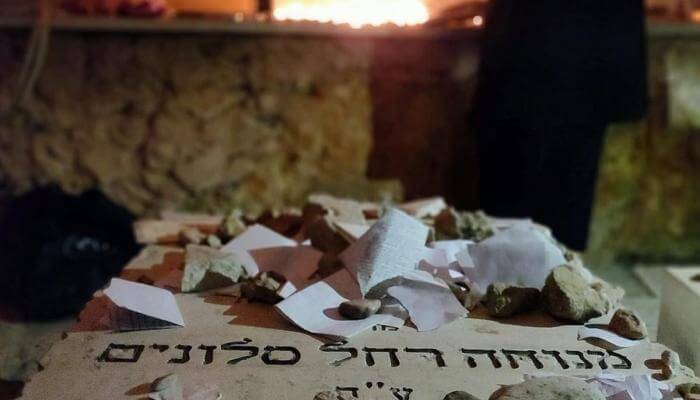Hundreds attend 131st memorial for Chabad Hebron matriarch Menucha Rochel Slonim
She helped Jews and Arabs, giving blessing and advice for over 49 years in Hebron.

Hundreds of Chassidim from around the country came to visit the grave of Rabbetzin Menucha Rochel Slonim, matriarch of the Chabad community in Hebron who passed away on this day 131 years ago.
Prayers were recited at her grave, followed by a festive farbrengin including speeches form prominent Chabad representatives from around the country. Notably absent was the recently decease Rabbi Zev Dov Slonim, descendant of Menucha Rochel and an important community leader in Jerusalem for decades.
Rebbetzin Menucha Rochel, the daughter of the Mittler Rebbe of Lubavitch, was born on the day her grandfather – Rabbi Shneur Zalman of Liadi, the “Alter Rebbe” – was released from prison in Russia. Her grandfather added “Rachel” as her middle name after his daughter who had died recently.
Menucha Rochel married Rabbi Yaakov Koli Slonim and together they raised a family in the town of Lubavitch. In 1815, her father the Rebbe sent shluchim, or emissary groups to strengthen the small, but ancient Jewish community in Hebron. He initiated the purchase of plots of land in the city and even purchased the “small synagogue” next to the Avraham Avinu Synagogue. This synagogue, which was ransacked in the 1929 massacre and later by the Jordanians, was restored and renovated and today is active.
After her father’s death, her brother-in-law, the Tzemach Tzedek, took over the leadership of Chabad. Upon his advice, Rebbetzin Slonim immigrated to the city with her family in 1845.
It has become customary to say says she and her family lived in a building known as the Schneerson House which belonged to the well-known Schneerson family. Now refurbished, there are seven Jewish families living in the building.
However, a historical examination shows that the house was probably built a few decades later. In addition, one of the famous stories about the Rebbetzin is a flood of rainwater that threatened to drown the city and was stopped only when the Sabbath candles reached the window of the Rebbetzin.
Even if we subtract the percentages required from the dramatic description, we find that the topographic description is not suitable for the location of this house. It turns out that the Rebbetzin’s home was located in what is now known as the main street of the Casbah, a street where there are quite a few appropriated Jewish properties.
Researchers identify the house in question in a structure known as the “House of the Haref”, near the “courtyard of the Kabbalists” in the heart of what is today a bustling Arab marketplace. Israeli access to the area is very limited.
Either way, the Slonim family occupied a central place in the small Jewish community of Hebron. The Rebbetzin became known as a master of wonders and many came to ask for her blessing, among them Arab neighbors. The Rebbetzin would also give them her blessings with joy, but conditioned them on not harming their Jewish neighbors.
The Rebbetzin Menucha Rochel passed away on the 24th of Tishmach, February 2, 1888, and was buried in the Ashkenazi section of the ancient cemetery in Hebron.
The cemetery was ravaged after the Jewish community was deported following the 1929 Hebron massacre. In the 1970s, the location of her tomb was identified by Prof. Ben-Zion Tavger, thanks to old British aerial photographs and other measurements on the ground.
Prof. Tavger erected a temporary tombstone on her grave and in 1998, in preparation for the 110th anniversary of her death, the site was renovated by the Jewish community in Hebron.
However, many other tombs in this plot which were vandalized during the Jordanian rule have not been restored and are still waiting for a breakthrough that will enable their restoration.
In preparation for the signing of the Hebron Accords in 1997, it turned out that the plot containing her grave was intended to be handed over to the Palestinian Authority. Thanks to public and political pressure across sectors, the plot, located strategically at the top of a hill and on the outskirts of the hostile Jabal al-Rahma neighborhood, was finally left under Israeli control.
Thus the Rebbetzin continues to defend the Jewish community of Hebron, more than a hundred years after her death.
Beyond the annual celebration, the place is always open and secure. It is possible to arrive at all times of the year without special coordination. In the evening hours there is a permanent Kollel in a nearby old stone building which was beautifully renovated.